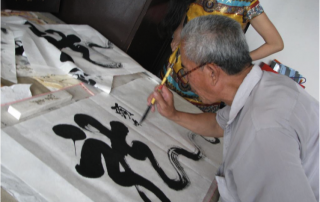In an increasingly computerized world, with a rapidly decreasing reliance on handwritten characters, Chinese people are losing the ability to write by hand. A 2010 survey by the China Youth Daily revealed an alarming statistic: 83% of the 2,072 young Chinese surveyed reported struggling with writing characters by hand. The phenomenon has become so widespread that it has even been given its own name: 提笔忘字 (tíbǐ wàngzì; literal translation: 'take pen, forget character').
Adapting Chinese to a Roman Keyboard
Because the Chinese language has thousands of characters, it would be impossible to create a usable, compact keyboard containing every single character. Therefore, the pinyin system, which uses a Roman keyboard, was adopted as the standard method of typing Chinese. While on their computers or cell phones, the majority of Chinese use this system, which involves typing in the Romanized transliteration of the Chinese characters, and then selecting the desired word from a list of characters with that same pinyin.

This method appeals to the recognition of correct characters from a group of many, but it does not require direct recall of specific strokes and radicals from memory. In this way, when time comes to put pen to paper, many Chinese simply draw a blank. By using computerized forms of writing, the intricacies of the handwritten character are neglected, and without practice, can even be forgotten entirely.
Why Bother Preserving Handwritten Chinese?
Chinese's intrinsic merits as a language are well-known: it is the oldest writing system in the world, and the only logographic language that never converted to some form of alphabet. It has largely remained the same throughout its 4000-year history. It is also distinguishable from other languages by its unique cultural significance -- the practice of handwritten Chinese has long been established as a discipline that brings a host of benefits, such as building willpower, improving intelligence, and strengthening personal character. Written Chinese has additional importance in the world of art: throughout Chinese history, calligraphy has been regarded as art of the highest intellectual calibre, above painting, sculpture, etc.
Many, more traditional, Chinese people lament the demise of handwritten characters, with the belief that their decline is analogous to a downfall in Chinese culture. They consider adapting the Chinese language to a Romanized method of writing has forced them to conform to the requirements of a strictly Western global society.
Out With the Old, In With the New?
China's long, vibrant history and customs are of course, very important to preserve and respect. However, maybe now it is time to welcome a new era in written Chinese. China's dynamic culture is not static; it is in constant evolution. It would be useless to rely upon an archaic and laborious method of writing Chinese, purely for the sake of respecting Chinese tradition. Nowadays, the vast majority of Chinese speakers are not calligraphers, but just ordinary people, trying to go about their day-to-day lives. If a Romanized keyboard makes their lives a bit easier, why not take advantage of it?
It is inevitable that, as we grow up along with technology, we become increasingly dependent upon it. Computerized writing systems provide us with efficiency and results that the human hand can't produce. Likewise, there are results that, fundamentally, cannot be replicated by a machine -- like calligraphy and art. These practices should be preserved too, in their own right. However, we should remember that in terms of pure communication, speed and efficiency will always prevail.